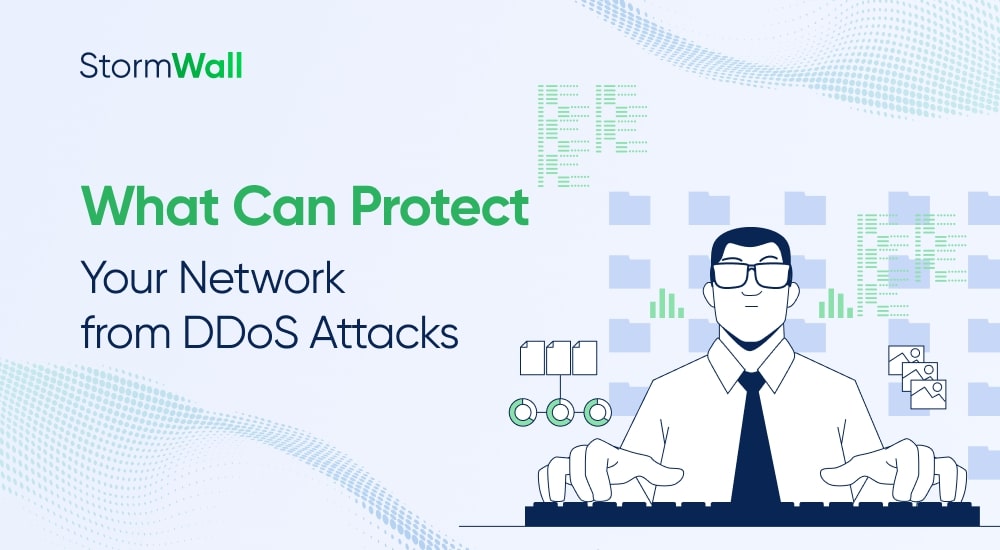Many customers see their anti-DDoS provider as a kind of wizard—wave a wand, and all cyber threats disappear. But in reality, protection isn’t that simple. Its effectiveness depends not only on the provider’s expertise and technology (though these are crucial) but also on the specific characteristics of the protected resources.
Some systems are easy to secure with minimal effort—just properly configuring DDoS protection services is often enough. Others, however, remain vulnerable even with the best anti-DDoS services. The ability of a system to withstand DDoS attacks with minimal time, cost, and effort is what we call DDoS protectability.

In this article we provide a brief guide that will help you improve the effectiveness of protecting networks and autonomous systems from DDoS attacks. It lists the aspects that should be taken into account and explains how to prevent DDoS attacks on a network effectively.
For a more general introduction to DDoS attacks and prevention, check out our beginner’s guide:
What Is a DDoS Attack and How to Protect Against It?
Network Protection Specifics
Ensuring a network’s protectability against DDoS attacks requires a well-structured defense strategy. A network often hosts multiple resources—websites, applications, and services—not only for its owners but also for their customers.
A high-volume DDoS attack targeting just one of these resources can put enormous strain on network infrastructure. The surge of illegitimate traffic can overwhelm even the most powerful routers, leading to service disruptions and potential failures.
And this isn’t just theory—DDoS attacks reaching hundreds of gigabits per second are now common. Not long ago, we even recorded an attack with a capacity of 1.5 Tbit/s.
It’s clear that edge hardware and software alone struggle to handle such massive attacks, making cloud-based anti-DDoS solutions a necessity.
Adding to the challenge, network operators typically manage large pools of IP addresses, which attackers exploit by launching numerous smaller DDoS attacks simultaneously. These low-intensity attacks can slip under the radar of traditional defenses, but their combined impact on edge devices can be severe—leading to reduced performance, operational instability, or even complete node failure.
Read also: How to Safeguard Corporate Networks from DDoS Attacks.
Step 1: Audit Your Network and Develop a DDoS Protection Strategy
Before implementing network protection, it’s essential to conduct a thorough network and information security (IS) audit. This will give you a clear picture of your infrastructure and help you build an effective DDoS defense strategy.
Here’s what to focus on during the audit:
1. Understand Your Network Architecture
- Identify how your network is structured and configured.
- Analyze traffic distribution, server capacity, and edge device performance.
- Determine how edge devices impact the rest of your infrastructure.
- Use Configuration Management Databases (CMDBs) if available—they provide valuable insights and are commonly maintained by data center and network operators.
2. Check Open Services and Ports
- Identify which network services and ports are active on edge devices.
- Disable any that aren’t needed to reduce potential attack surfaces.
3. Evaluate Existing Security Measures
- Review the current security tools in place, how they are managed, and how they interact.
- Identify gaps or inefficiencies in DDoS protection coordination.
4. Define Critical Assets That Need Protection
- Identify key devices, services, ports, and IP addresses that require DDoS protection.
- Keep in mind: Partial protection is not enough. A truly effective strategy must provide comprehensive coverage across all layers:
- Network & Transport Layers (L3/L4) – Defense against volumetric and protocol-based attacks.
- Application Layer (L7) – Protection for DNS, HTTP, and HTTPS services from more sophisticated DDoS threats.
Once you have a complete understanding of how to protect your network from DDoS attacks, you can develop a structured DDoS protection strategy and plan the next steps accordingly.
Step 2: Gather Network Information for Your Anti-DDoS Provider
The more information you provide to your anti-DDoS provider, the faster and more effectively they can help secure your network. A good provider will actively request detailed network data—this is a sign of a professional approach and a well-tailored protection strategy.
Using insights from your network and security audits, prepare a comprehensive network overview. This will help you and your provider choose the best option for network protection against DDoS attacks and develop a customized security strategy based on your infrastructure, traffic patterns, and vulnerabilities.
Your provider will need specific details about your network, such as which IP addresses host your DNS servers, where your VPN gateways are located, and which IP addresses handle high traffic volumes (e.g., NAT pools). If you use caching proxies like Squid or BlueCoat, you should share their IP addresses as well.
Some caching services—such as Google Global Cache (GGC), Facebook Network Appliance (FNA), Netflix caching, and Akamai—occasionally generate large bursts of traffic. If your provider is unaware of these, they may mistakenly block them as DDoS attacks. Providing this information ensures proper DDoS protection configuration.
It’s also important to clarify which IP addresses belong to full-fledged internet clients that require both incoming and outgoing traffic (e.g., VDS/VPS, end users) and which ones belong to web servers, shared hosting, or other services that don’t need full protocol access. This helps create precise protection profiles and allows your provider to implement better countermeasures against network reconnaissance attempts.
Informing your provider about your routing devices helps them assess performance and recommend upgrades if needed. Low-end MikroTik routers, for example, struggle with even weak DDoS attacks (100-200K packets/sec), so stricter filtering policies may be required. Cisco ASR series routers should handle 5-6 million packets/sec, but if they struggle under normal loads, adjustments may be needed to improve performance and resilience.
By sharing detailed network insights, you enable your anti-DDoS provider to build a robust, efficient, and customized protection strategy tailored to your needs.

Network Protection from DDoS Attacks
Step 3: Close Unused Ports and Conceal Unused IP Addresses
Your network should appear as much like a “black box” as possible from an attacker’s perspective. Hackers often search for vulnerabilities, weak spots, and unprotected resources—sometimes even ones you might have missed during your audit—to launch DDoS attacks.
To minimize this risk, create a detailed list of active and inactive network services and resources. Then, close off anything that’s not in use to prevent attackers from exploiting them.
You’ll also want to make it harder for attackers to analyze your network. One effective strategy is to hide your peering IP addresses from Traceroute, both externally and internally. Keep in mind that threats can come not only from outside attackers but also from insiders—this includes your own staff or employees of client companies hosting their resources on your network.
For addresses that can’t be hidden, protect them with access control lists (ACLs). Check with your anti-DDoS provider to set this up.
Step 4: Ensure Adequate Performance of Edge Devices
One of the most common reasons networks struggle with DDoS attacks is underpowered edge devices—routers, firewalls, load balancers, and other infrastructure components. These devices may handle normal traffic just fine, but even a relatively small DDoS attack can take them down.
We frequently encounter Cisco ASA firewalls (especially older models) and MikroTik routers that fail under attack. Many networks also rely on small-office-grade hardware or outdated equipment—once effective, but now unable to handle modern DDoS threats.
Even the best anti-DDoS solutions can’t filter out 100% of an attack. If just 1% of a large-scale attack (e.g., 50 Gbps) bypasses filtering, it can overload edge devices by tens or even hundreds of times.
With stateful packet inspection (SPI) enabled, performance drains even faster. In severe cases, devices become so overloaded that they can’t process legitimate traffic or even report their status, making troubleshooting impossible.
- Identify weak devices through a network audit and replace them with higher-performance alternatives. Without this, even the best anti-DDoS protection won’t prevent failures.
- Expand bandwidth capacity—a strong attack can overwhelm not only devices but also your internet uplinks. Scaling up existing bandwidth and adding backup channels will help maintain stability.
By upgrading edge infrastructure and ensuring sufficient bandwidth, you can significantly improve your network’s DDoS resilience and keep it running even under heavy attack.
Step 5. Perform a Stress Test
You can assess your network’s resistance to DDoS attacks by running stress tests with publicly available tools, such as hping3, which is included in many Linux distributions. This utility allows you to simulate different types of attacks with adjustable parameters. However, it’s important to use it carefully, gradually increasing the load to avoid unintended disruptions.
Stress testing should also be conducted regularly after implementing DDoS protection. This helps you gauge what happens when even a small amount of attack traffic reaches your network. Additionally, it allows you to evaluate your anti-DDoS provider’s responsiveness—how quickly they react to an attack, whether they provide support outside business hours, and how effectively they mitigate the threat.
Read also: Why Stress Tests and Other DDoS Protection Checks Are So Important.
Step 6: Protect Your DNS Servers
In the first half of 2022, DNS attacks became the second most common type of DDoS attack, right after HTTP floods. This makes DNS protection a top priority—without it, a targeted attack could cause instability, leading to resource availability issues for users.
If your DNS server is hosted within your network, you can protect it using BGP announcements—but only if your anti-DDoS provider supports DNS attack filtering (not all do!). If your provider offers this feature, share your DNS server addresses with them and request customized traffic filtering to ensure stable operation.
Step 7: Integrate DDoS Protection into Your Overall Security Strategy
DDoS protection should be seamlessly integrated into your organization’s information security (IS) strategy and overall cyber risk management plans. It’s not a standalone measure—it needs to work in sync with other security processes to ensure a comprehensive defense against evolving threats.
To achieve this, DDoS protection should be closely coordinated with:
- Vulnerability management – Identifying and patching weak points before attackers exploit them.
- Configuration management – Ensuring security settings are optimized to withstand attacks.
- Incident response – Having a clear plan for detecting and mitigating DDoS threats in real time.
- Monitoring and auditing – Continuously assessing network activity to detect early signs of an attack.
As DDoS threats evolve, your network must also adapt:
- Conduct regular security audits and vulnerability assessments.
- Analyze past attacks to understand patterns and prevent future threats.
- Perform stress tests to evaluate your network’s resilience under load.
- Consult with your anti-DDoS provider to address vulnerabilities proactively and improve security configurations.
By continuously refining and aligning your DDoS protection strategy with broader IS processes, you ensure long-term resilience against the ever-growing threat of cyberattacks.
How to Prevent DDoS Attacks on Your Network: Final Checklist
- Perform a network audit and develop a DDoS protection strategy
- Gather key network details for your anti-DDoS provider
- Close unused ports and conceal unused IP addresses
- Ensure edge devices can handle DDoS traffic
- Run stress tests to evaluate network resilience
- Implement strong protection for DNS servers
- Integrate DDoS protection into your overall security strategy
By following these steps, you can protect your network from DoS attacks and significantly reduce the risk of downtime due to these threats.

StormWall for Networks:
DDoS protection for networks via BGP
- Activate protection within 10 minutes
- 24/7 technical support




















